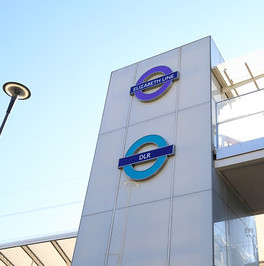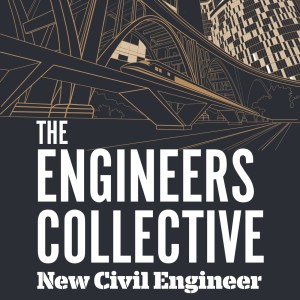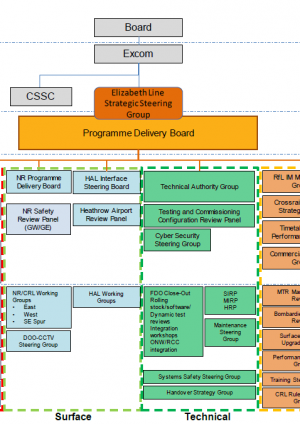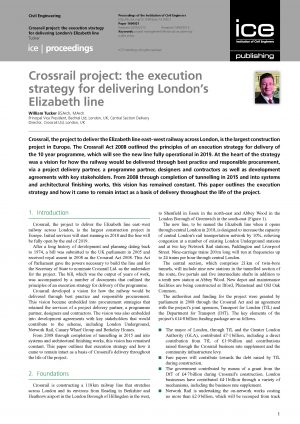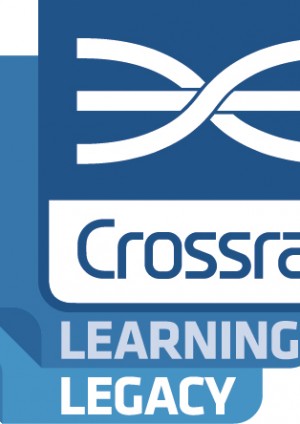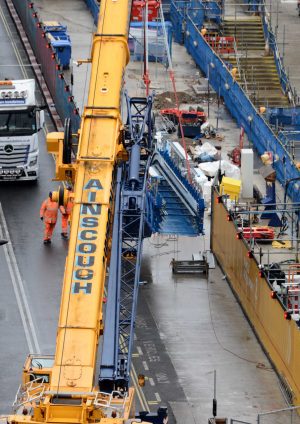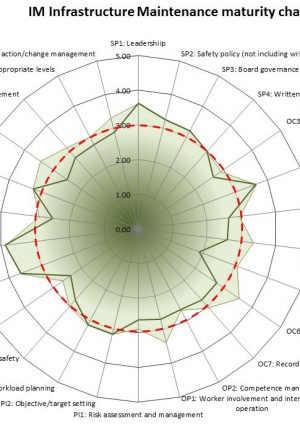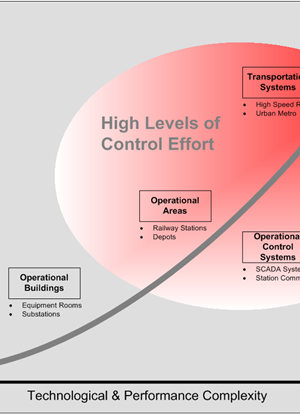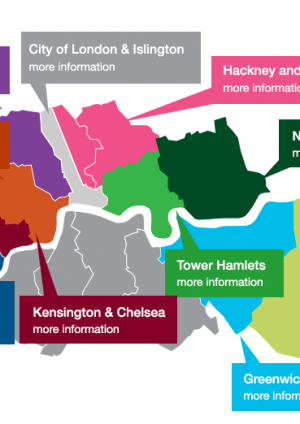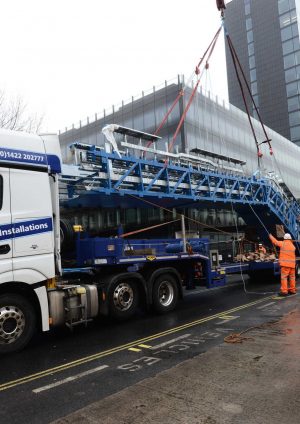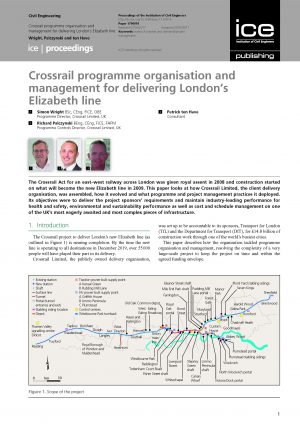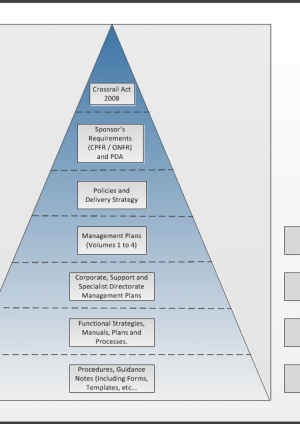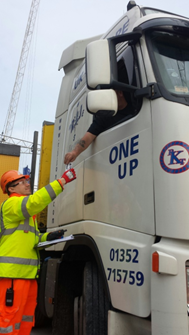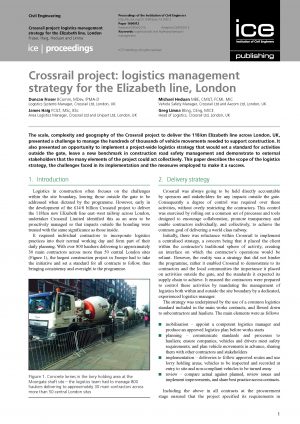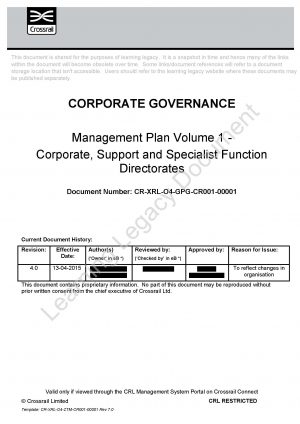Delivery/Execution Strategy
 Crossrail is the largest single addition to the London transport network for over 50 years. It is a complex programme of interrelated projects and works that need to be integrated to create the new rail service. Crossrail Ltd (CRL) is responsible for development and delivery of the new infrastructure, in accordance with the requirements of the Sponsors, up to the point at which it is accepted by the long-term operators of the infrastructure.
Crossrail is the largest single addition to the London transport network for over 50 years. It is a complex programme of interrelated projects and works that need to be integrated to create the new rail service. Crossrail Ltd (CRL) is responsible for development and delivery of the new infrastructure, in accordance with the requirements of the Sponsors, up to the point at which it is accepted by the long-term operators of the infrastructure.
The scope of Crossrail is derived from the requirements defined in the following documents:
- Crossrail Act 2008 and associated commitments including the Environmental Minimum Requirements and the Undertakings and Assurances;
- Crossrail Project Development Agreement and associated Sponsors Requirements;
- Crossrail Programme Functional Requirements (CRL’s detailed interpretation of the Sponsors Requirements); and
- Other agreements and commitments (eg, with industry partners such as Network Rail, London Underground, Berkeley Homes, Canary Wharf Group, etc)
Crossrail developed a Delivery Strategy which defines how CRL is delivering Crossrail. It is intended to provide a common purpose and clear direction for everyone and every organisation, particularly CRL’s staff and its partners, involved in the delivery of Crossrail and formed the basis for development of systems and procedures that would control the project.
The delivery model implemented by CRL and its supply chain was driven by a number of key inputs, including establishing clear accountabilities and authorities, maintaining a commitment to responsible procurement, understanding the industry’s supply chain capacity and traversing the long geographical footprint of the scheme. The basic architecture of that model, which identified a programme management organisation responsible for:
- delivery of both the central operating section and on-network works;
- an operations organisation responsible for those activities required for a staged opening of services;
- a finance and commercial organisation that allowed Crossrail Ltd. to operate as a company and support delivery of the programme.
Within that model, however, the organisational structure changed and evolved over time from its initial procurement of design and construction contracts through major tunnelling and into fit-out, testing, commissioning and handover of the assured railway.
A learning legacy paper on the Delivery Organisation Evolution reviews the delivery model for the project and how the organisation evolved during the construction phase. It identifies the key benefits and lessons learned by Crossrail and how it might influence future major infrastructure projects in developing an organisational structure best suited to address the particular driving factors over the life of the project.
Crossrail identified logistics early on as a key priority and that it should be proactively managed such that the impacts outside the hoarding were treated with the same significance as those inside, requiring individual contractors to incorporate logistics practices into their normal working day. The learning legacy paper on Logistics provides an overview of the principles of Crossrail’s logistics strategy and how it was implemented, identifying the key challenges, lessons learned and how it continues to influence other projects and stakeholders.
| Summary |
Publication date |
Document Type |
Topic area: Delivery/execution strategy In 2018 it was announced that the Crossrail programme could not be delivered to the original timescale and budget. The project sponsors made changes to the Board and Executive in response.
This paper describes the leadership lessons learned in resetting the project in 2019–2020 and discusses the broader implicatio...
|
05/04/2023 |
Journal Publication |
Topic area: Delivery/execution strategy The second report from ICE’s Systems Approach to Infrastructure Delivery review shows how infrastructure projects, programmes, and supply chain businesses are using systems thinking to deliver better outcomes.
In December 2020, ICE published the findings of a major review into improving the delivery of major infrastr...
|
20/04/2022 |
Case Study |
Topic area: Delivery/execution strategy Leading practitioners in the field of rail megaprojects discuss whether rail projects really are a “nightmare” to deliver.
In Britain alone, the rail industry facilitates travel for around 1.7 billion passengers every single year. Behind these journeys lie highly complex projects, which have been labelled a nightma...
|
14/09/2021 |
Video |
Topic area: Delivery/execution strategy Mark Wild appeared on New Civil Engineer magazine’s Engineers Collective podcast on 26 February 2020 to discuss the complexities of delivering a mega project and talk about the reasons behind delayed delivery of Crossrail...
|
26/02/2020 |
Audio |
Topic area: Delivery/execution strategy The Crossrail Project is a very large and complex programme with tight timescales. This document provides an overview of the programme governance framework used at Crossrail to control the leadership, decision-making, reporting and management of the Crossrail Project to achieve its objective to deliver a world-class in...
|
02/08/2018 |
Micro-report |
Topic area: Delivery/execution strategy Crossrail, the project to deliver the Elizabeth line east–west railway across London, is the largest construction project in Europe. The Crossrail Act 2008 outlined the principles of an execution strategy for delivery of the 10 year programme, which will see the new line fully operational in 2019. At the heart of t...
|
13/03/2017 |
Journal Publication |
Topic area: Wider stakeholders/Public Affairs Crossrail ran a Learning Legacy programme to collate and disseminate the lessons from delivering the programme for the benefit of future major projects.
This micro-report explains how the learning legacy was set up and managed and provides some suggestions for improvement for future learning legacies....
|
19/05/2023 |
Technical Paper |
Topic area: Completing the Elizabeth line event presentations
|
03/05/2023 |
Video |
Topic area: Programme Controls In early 2020, following the 2018 announcement of significant delay to the opening of Crossrail and the associated cost increases, the Crossrail programme was hit by yet another blow – COVID-19. The programme stopped all work in March 2020 and set about developing a recovery strategy to achieve the original object...
|
05/04/2023 |
Journal Publication |
Topic area: Operations Management The delivery of Elizabeth line operations from concept to passenger service has ultimately been very successful. The line is a new type of service in the UK, analogous to the French RER or German S-Bahn systems, and brings together (i) major new infrastructure, (ii) new rules and regulations (as it is a unique railw...
|
05/04/2023 |
Journal Publication |
Topic area: Rail systems At the beginning of the Testing and Commissioning phase Crossrail anticipated 6 months of Dynamic Testing, 5 days a week, and required quick insights to testing observations on site. Existing processes were archaic and it wasn’t easy to get visibility of testing observations from site to management in a timely manner...
|
05/10/2020 |
Micro-report |
Topic area: Logistics The dataset below provides all the data collected from a sample of the main central project sites on the movement in and out of site by HGVs. The data is broken down by date and material being moved.
A set of sample dashboards from a selection of stations shafts and portals is included to demonstrate how Crossrail util...
|
17/08/2018 |
Dataset |
Topic area: Operations Management The Office of Rail and Road has adapted its Risk Management Maturity Model (RM3) from the HSG65 HSE guideline and made it relevant to rail organisations. The model defines excellence on a 5-point scale, across a number of different disciplines.
This micro-report describes how Crossrail applied this approach in an innov...
|
14/08/2018 |
Micro-report |
Topic area: Systems Integration and Technical Assurance Crossrail’s Central Operating Section is characterised by high performance requirements of a metro system with high specified train service throughput. This is realised via multiple interdependent electronic systems which control the movement of trains together with station systems, traction and auxiliary power suppl...
|
09/07/2018 |
Technical Paper |
Topic area: Traffic and Highways Due to the size and complexity of the Crossrail project, it was decided to try and mitigate traffic issues by liaising with the affected London boroughs from the outset. Approved lorry routes were agreed with each of the London boroughs where Crossrail construction sites were required. The routes agreed with each of th...
|
09/07/2018 |
Good Practice Document |
Topic area: Logistics Paddington station has been used as an example to detail the controlled manner in which HGV lorry movements were managed during construction over a five year period. This paper provides a summary of the site construction, the HGV movement logged, and how that movement is linked to construction at the site. It also show...
|
09/07/2018 |
Micro-report |
Topic area: Project and Programme Management Crossrail established four key objectives on the project:
Are we safe?
Are we on time?
Are we within funding?
Are we world class?
These four objectives drive all aspects involved in the successful completion of the project and form the foundations of the Crossrail Key Performance Indicators (KPIs). This micro report ou...
|
09/07/2018 |
Micro-report |
Topic area: Programme Controls The Crossrail Act for an east–west railway across London was given royal assent in 2008 and construction started on what will become the new Elizabeth line in 2009. This paper looks at how Crossrail Limited, the client delivery organisation, was assembled, how it evolved and what programme and project management prac...
|
19/09/2017 |
Journal Publication |
Topic area: Quality This paper examines Crossrail’s concept of establishing and implementing a management system that ensured that all key processes were mapped, describing the approach taken and setting out how the Management System was developed. It discusses the challenges encountered throughout the lifecycle of the Programme and how...
|
04/04/2017 |
Case Study |
Topic area: Information Technology This document summarises the approach taken by Crossrail’s IT department to deliver a system that would meet the requirements of Crossrail’s Traffic Co-ordination Centre and how the challenges inherent in a complex, bespoke system were met.
|
14/03/2017 |
Micro-report |
Topic area: Logistics Logistics in construction often focuses on the challenges within the site boundary, leaving those outside the gate to be addressed when dictated by the programme. But early in the projects development Crossrail identified this as an area which it wanted to be proactively managed so that impacts outside the hoarding wer...
|
14/03/2017 |
Journal Publication |
Topic area: Quality The Crossrail Management Plan, documents the arrangements adopted by Crossrail for the delivery of the Crossrail Programme in accordance with the Delivery Strategy. It is arranged into four volumes as follows:
Volume 1: Corporate, Support and Specialist Function Directorates
Documents the governance arrangements and re...
|
14/03/2017 |
Good Practice Document |
 Crossrail is the largest single addition to the London transport network for over 50 years. It is a complex programme of interrelated projects and works that need to be integrated to create the new rail service. Crossrail Ltd (CRL) is responsible for development and delivery of the new infrastructure, in accordance with the requirements of the Sponsors, up to the point at which it is accepted by the long-term operators of the infrastructure.
Crossrail is the largest single addition to the London transport network for over 50 years. It is a complex programme of interrelated projects and works that need to be integrated to create the new rail service. Crossrail Ltd (CRL) is responsible for development and delivery of the new infrastructure, in accordance with the requirements of the Sponsors, up to the point at which it is accepted by the long-term operators of the infrastructure.